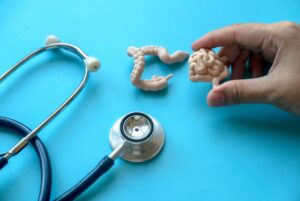Pilonidal sinus is a condition that, although it may seem rare, affects many people, especially young people and men. This condition presents as a small cyst or cavity in the lower back, right in the sacral area, and can cause significant discomfort if not treated properly.
At Innova Cirugía, we will explore in depth how to detect a pilonidal sinus, its symptoms, causes, treatment options and prevention measures.
What is a Pilonidal Sinus?
Pilonidal sinus is a skin abnormality that manifests itself as a cyst or small tunnel that forms in the sacral region. It generally develops in the midline of the body, near the crease of the buttocks. The condition may be related to the growth of body hair, skin friction, and genetic factors, among others.
Pilonidal Sinus Anatomy
The pilonidal cyst contains necrotic tissue, hairs, and often secretions. This can lead to recurring infections, which are one of the reasons many people seek medical attention. Over time, if left untreated, the cyst can increase in size and cause more severe symptoms.
Common Symptoms
Detecting a pilonidal sinus can be complicated, since the symptoms can vary in intensity. Some of the most common signs include:
- Localized Pain: One of the most notable symptoms is pain in the affected area. This pain can be sharp or dull, and is often intensified by sitting or doing activities that involve the lower back.
- Inflammation and Redness: The skin around the cyst may become red and inflamed, indicating a possible infection. This inflammation can be painful to the touch.
- Discharge: In some cases, there may be drainage of pus or fluid from the cyst. This drainage may be smelly and is a clear sign of infection.
- Presence of Hair: In many cases, ingrown hair is observed in the affected area, which can contribute to the formation of the cyst.
- Fever and General Malaise: If the infection worsens, systemic symptoms such as fever, chills and general malaise may occur.
Who May Be Affected?
Pilonidal sinus is more common in young men, especially those who lead a sedentary lifestyle, spend a lot of time sitting, or who are overweight. It has also been observed that people with a family history of this condition are more predisposed to developing it.
Risk Factors
Factors that may increase the risk of developing a pilonidal sinus include:
- Sedentary lifestyle: Spending long hours sitting can increase friction in the sacral area.
- Obesity: Excess weight can contribute to pressure and friction in the affected area.
- Dense body hair: People with a lot of hair in the sacral area may be at higher risk of developing this condition.
- Lack of hygiene: Poor personal hygiene can facilitate skin infections.
Diagnosis
If you suspect that you may have a pilonidal sinus, it is essential to see a doctor for an accurate diagnosis. The professional will perform a physical examination and, in some cases, may order imaging studies, such as ultrasounds or MRIs, to evaluate the extent of the condition.
Diagnostic Process
- Physical Examination: The doctor will examine the affected area, looking for signs of inflammation, redness, and discharge.
- Medical History: You will likely be asked about your symptoms, medical history, and any previous treatments you have received.
- Pruebas de Laboratorio: En casos de infección, se pueden realizar cultivos para identificar el tipo de bacteria presente y determinar el tratamiento adecuado.
Treatment Options
Pilonidal sinus treatment can vary depending on the severity of the condition. Options include:
- Conservative Treatment: In mild cases, the doctor may recommend measures such as sitz baths, hot compresses, and anti-inflammatory medications to relieve pain and reduce inflammation.
- Surgical Drainage: If there is a significant infection or the cyst is large, surgical drainage may be necessary. During this procedure, a small incision is made to drain pus and affected tissue.
- Surgical Removal: In recurrent or severe cases, complete removal of the cyst and surrounding tissue may be considered. This procedure is performed under general anesthesia and may require a longer recovery time.
- Antibiotics: If an infection is identified, antibiotics may be prescribed to help fight it. It is essential to complete the course of antibiotics according to the doctor’s instructions.
Prevention
To reduce the risk of developing a pilonidal sinus, it is advisable to follow certain hygiene and personal care measures:
- Maintain Good Hygiene: Make sure to clean the sacral area well, especially after exercising or sweating.
- Avoid Tight Clothing: Clothing that puts pressure on the area can increase the risk of irritation and friction.
- Control Body Hair: Consider removing hair in the affected area to reduce the risk of ingrown hair.
- Maintaining a Healthy Weight: Adopting an active and balanced lifestyle can help reduce pressure in the sacral area.
- Avoid Sitting for Prolonged Periods: If you work in a sedentary environment, try to get up and move every once in a while.
Conclusion
Detecting a pilonidal sinus early can make the difference in treatment and recovery. If you experience related symptoms, do not hesitate to consult a health professional. Early care can avoid complications and improve your quality of life.
While pilonidal sinus can be uncomfortable and painful, there are effective treatment options that can help relieve symptoms and prevent future episodes. Don’t underestimate the importance of taking care of your health and well-being.
If you suffer from pilonidal sinus or need care for colorectal pathologies, do not hesitate to contact Innova Cirugía. Our specialized team will offer you innovative and effective treatments to ensure your well-being and rapid recovery.




